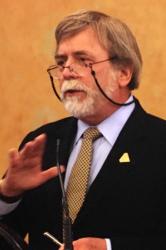Penn and Princeton have enjoyed a rich, albeit sometimes tumultuous, rivalry.
The University of Pennsylvania was a major football power for many decades until choosing to deemphasize the sport in the mid-1950s. Just as it is sometimes hard to reconcile the modern-day programs of the “Big 3” of the day–Harvard, Yale, and Princeton–with their dominance of college football in the first 50 years of the sport, so it is with the Penn Quakers.
Pennsylvania began playing intercollegiate football on an informal basis in the Centennial Year of 1876. The first game was on November 1, resulting in a 6-0 loss to Princeton.
This wasn’t acceptable, so Penn got serious enough about the sport to hire its first coach, Frank Dole, for the 1885 season. Dole did fairly well, compiling a 23-19-1 record in three seasons. During Dole’s tenure, Penn played up to 17 games a season, competing three times each year against Princeton. Even though Dole had some overall success, his teams continued to lose to Princeton, coming up short nine times. That made it 0-20 against the Tigers from New Jersey, located just 40 miles away.
In 1888, E.O. Wagenhurst took over the coaching duties and had a respectable 38-18 record in his four seasons at the helm. However, he was 0-7 against Princeton, and now Penn had lost 27 straight times to its chief rival. The overall points scored in the series found Princeton having run up an embarrassingly decisive margin, 867-46, for an average rounded-off score of 32-2.
Something had to be done!
In 1892, George Woodruff, a 28-year-old former all-around athlete at Yale, took over the Penn football program. Woodruff had a knack for coming up with innovative, unexpected offensive plays, and his arrival began a golden era for Quaker football.
Woodruff’s 1892 team compiled a 15-1 record, losing only to Yale in a game played in New York City. Importantly, Penn beat Princeton for the first time, winning 6-4. In 1893, Princeton edged the Quakers 4-0. The overall record for Penn that year was 12-3, with the other two losses being to Yale and Harvard.
1894 was the decisive year in the Penn-Princeton rivalry. Woodruff had been perfecting an innovative offensive scheme and saving it just for the Princeton game. The boys from Pennsylvania went to Trenton, New Jersey, where the game was to be played on November 10, sporting a perfect 9-0 record. Princeton was 7-0. 12,000 ardent fans turned out to see the battle between the two undefeated teams.
For the first time, Coach Woodruff unveiled his carefully kept secret, the “guards back” offense. The Penn quarterback, Carl Williams, would call out “guards right!” or “guards left!” The two guards would drop back to either the right or left side of their quarterback, giving the Quakers two extra men to run interference. The play would usually be run toward the side the guards had lined up on, but to keep the defense honest, sometimes it would go in the opposite direction. Princeton simply couldn’t adjust to the new offensive formation and remained befuddled all afternoon. Penn won 12-0.
Penn’s 1894 undefeated team went 12-0 with four All-Americans. The Quakers beat not only Princeton but also Harvard and were determined to be the National Champions.
Philadelphia was the home not only of the University of Pennsylvania but a great number of the Princeton alumni also lived in the perhaps misnamed “City of Brotherly Love.” Mayhem broke out after the game as the Princetonians returned to their homes in Philadelphia on the train, and the accompanying Penn alumni and students began to harass them as they all traveled.
The jeering and what had been good-natured razzing got somewhat ugly when a large number of Penn partisans met the train as it arrived, cheering and singing songs, and then began to get rowdy while streaming away from the terminal and into the streets.
A quick-witted Penn fan wrote a song that was passed out to the revelers and used to taunt the Tiger supporters.
OH MY! OH MY!
HOW WE BLACKED THE TIGER’S EYE.
WHAT’VE YOU DONE? WHAT’VE YOU DONE?
BEAT THE TIGERS TWELVE TO NONE.
HOW DID YOU DO IT? HOW DID YOU DO IT?
EASY! EASY!
WHAT’S THE SCORE? THREE TIMES FOUR.
PRINCETON’S TIGER’S ON THE FLOOR!

Penn’s 1894 undefeated team went 12-0 with four All-Americans. The Quakers beat not only Princeton but also Harvard and were determined to be the National Champions. (Note: Coach Woodruff is in the middle of the 3rd row with a tie.)
The celebrations continued on into the evening. A theatre performance was interrupted. Wannamaker’s department store became the scene of some “unpleasantness” as the crowd raced through, “knocking female shoppers too and fro.”
A few days after the 1894 game, the Princeton faculty convened and voted to suspend future athletic contests with Penn. Not to be outdone, the Penn faculty decided to meet and voted similarly, prohibiting any contact with Princeton’s teams.
Each school waited for the other to call, but it was over 40 years before the Pennsylvania Quakers and Princeton Tigers met again on the gridiron! Finally, in 1935, there was a truce-“Old boy, tell me now, why is it that we are mad at each other?”–and Princeton beat Penn, 7-6, on October 5 at Princeton’s Palmer Stadium in front of 50,000 fans, and the two institutions have played most years since.
Since the resumption of the series in 1935, Penn has won 41 games, Princeton has won 39, and one game has ended in a tie. Overall, the two prestigious universities have played 112 times since that first game in 1876.



















